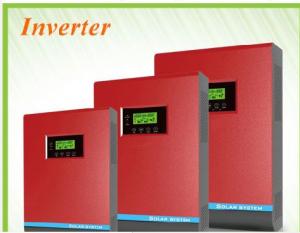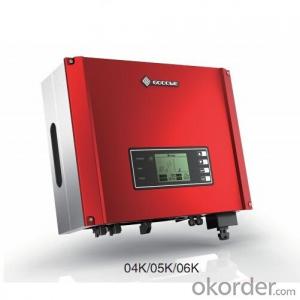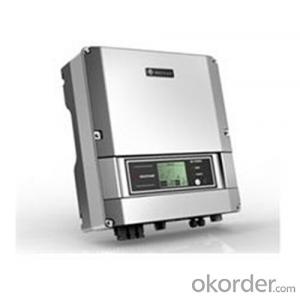Mpp Solar Inverter 12v On Grid Solar Inverter GW4200-DS
OKorder Service Pledge
OKorder Financial Service
You Might Also Like
GW4200-DS
GW4200-DS photovoltaic inverter is suitable for home rooftop photovoltaic system, designed under modern industrial concept.
There are three colors for option with fashionable appearance.
This model uses advanced digital control technology and communication method as well as super MPP tracking and security technology.
It has a wide range of input and output voltage.
To ensure its stability and long service life, our inverter is manufactured with optimum quality components.
It holds a safe lead among the same level of products.
Datasheet

- Q: Can a solar inverter be used with a solar-powered irrigation system?
- Yes, a solar inverter can be used with a solar-powered irrigation system. A solar inverter is responsible for converting the direct current (DC) produced by the solar panels into alternating current (AC), which is required to power various electrical devices. In the case of a solar-powered irrigation system, the solar inverter can convert the DC generated by the solar panels into AC to power the irrigation pump or other electrical components of the system. This ensures that the solar energy captured by the panels can be effectively utilized for irrigation purposes.
- Q: What is the expected lifespan of a solar inverter?
- The expected lifespan of a solar inverter can vary depending on several factors such as the quality of the equipment, usage patterns, and maintenance. On average, a well-maintained solar inverter can last between 10 to 15 years. However, some high-quality inverters have been known to last up to 20 years or more. Regular maintenance and monitoring can help prolong the lifespan of the inverter and ensure optimal performance throughout its lifespan.
- Q: What is the role of a solar inverter in voltage and frequency regulation during grid disturbances?
- The role of a solar inverter in voltage and frequency regulation during grid disturbances is crucial to maintaining the stability and reliability of the electrical grid. During grid disturbances, such as voltage fluctuations or frequency deviations, the solar inverter acts as a control device that helps regulate and stabilize the electrical parameters. In terms of voltage regulation, the solar inverter continuously monitors the voltage level of the grid and adjusts its output accordingly. If there is an increase in grid voltage, the inverter will reduce its output to prevent overvoltage conditions. Conversely, if there is a decrease in grid voltage, the inverter will increase its output to compensate and maintain a stable voltage level. This regulation ensures that the voltage supplied by the solar inverter aligns with the grid's voltage requirements, preventing damage to electrical equipment and ensuring the safe operation of the grid. Similarly, the solar inverter also plays a role in frequency regulation during grid disturbances. The inverter constantly monitors the frequency of the grid and adjusts its output frequency to match the grid's frequency. If the grid frequency deviates from the standard frequency, the inverter will modify its output frequency to bring it back to the desired level. This frequency regulation is essential for maintaining the synchronization of various electrical devices connected to the grid, preventing equipment damage, and ensuring the stability of the grid. Overall, the solar inverter's role in voltage and frequency regulation during grid disturbances is to provide stability and reliability to the electrical grid. It acts as a control device that continuously monitors and adjusts its output to maintain the desired voltage and frequency levels, thus preventing potential damage to electrical equipment and ensuring the smooth operation of the grid.
- Q: How does a solar inverter handle voltage transients?
- A solar inverter handles voltage transients by regulating and stabilizing the incoming DC voltage from the solar panels, and converting it into a steady AC voltage suitable for use in the electrical grid or for powering appliances. It uses various electronic components and control algorithms to monitor and adjust the voltage levels, ensuring that any sudden changes or fluctuations in the input voltage are smoothed out and the output remains consistent and within acceptable limits.
- Q: How does a solar inverter handle shading or partial panel obstructions?
- A solar inverter handles shading or partial panel obstructions by employing a technique known as Maximum Power Point Tracking (MPPT). MPPT enables the inverter to optimize the output power of the solar panels by constantly adjusting the operating voltage and current. When shading or obstruction occurs, the inverter automatically detects the affected panels and adjusts their output to minimize the impact on the overall system performance. This ensures that the system continues to generate as much power as possible, even in shaded conditions.
- Q: How does a solar inverter affect the voltage stability of a solar system?
- A solar inverter plays a crucial role in maintaining voltage stability in a solar system. It converts the direct current (DC) generated by solar panels into alternating current (AC) suitable for use in homes and businesses. By monitoring and adjusting voltage levels, a solar inverter ensures that the power output remains consistent and within acceptable limits. This helps to prevent voltage fluctuations, voltage drops, and other electrical instabilities, ensuring a stable and reliable power supply from the solar system.
- Q: What is the difference between a single-phase and three-phase solar inverter?
- A single-phase solar inverter is designed to convert the DC power generated by solar panels into AC power for use in a single-phase electrical system. It is suitable for smaller residential installations. On the other hand, a three-phase solar inverter is capable of converting DC power into AC power for use in a three-phase electrical system. It is typically used in larger commercial or industrial solar installations. The main difference lies in the electrical system they are compatible with and the scale of the solar installation they can support.
- Q: What is the maximum input voltage that a solar inverter can handle?
- The maximum input voltage that a solar inverter can handle depends on the specific model and make of the inverter. It can vary widely, but typically ranges between 600V to 1000V DC for residential inverters, and higher for commercial or utility-scale inverters.
- Q: Can a solar inverter be used with energy storage systems?
- Yes, a solar inverter can be used with energy storage systems. In fact, it is a crucial component in connecting solar panels with energy storage batteries. The solar inverter converts the direct current (DC) electricity generated by the solar panels into alternating current (AC) electricity, which can be used to power appliances and charge the energy storage system. Additionally, the inverter also manages the flow of electricity between the solar panels, energy storage system, and the grid, ensuring efficient and reliable power supply.
- Q: Can a solar inverter be used for both residential and commercial applications?
- Yes, a solar inverter can be used for both residential and commercial applications. Solar inverters are designed to convert the direct current (DC) electricity generated by solar panels into alternating current (AC) electricity, which is suitable for use in homes and businesses. They are versatile and can be scaled up or down depending on the size of the solar power system, making them suitable for both residential and commercial installations.
Send your message to us
Mpp Solar Inverter 12v On Grid Solar Inverter GW4200-DS
OKorder Service Pledge
OKorder Financial Service
Similar products
Hot products
Hot Searches
Related keywords



























